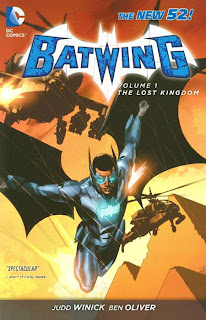It's the trade-waiter's dilemma that this glowing review of Judd Winick's second DC Comics New 52 series,
Batwing: The Lost Kingdom, comes just after the news that Winick
has quietly announced his departure from
Batwing and from DC Comics in general. This, after Winick also left
Catwoman and apparently turned down a stint on
Green Arrow. More's the pity, in a week where DC's reputation for creator relations is already taking a hit in the form of Rob Liefeld's much more public walk-off from his DC titles.
Winick's first
Batwing collection is cogent superhero comics with an international flair of the kind also found in Winick's later
Outsiders work. His
Batwing also has charmingly much in common with the adventures of former Bat-proteges such as Azrael Jean Paul Valley and Batgirls Cassandra Cain and Stephanie Brown; Winick does well imagining the new junior member of the Bat-squad.
Minds are made up quickly, but Winick's work on
Batwing ought give anyone who dismissed his work on
Catwoman as cheap or trashy a second thought.
Batwing is a well-crafted book, and it's impossible to appreciate the thought given to
Batwing without acknowledging that same thought must have gone into the
Catwoman book as well.
[Review contains spoilers]As with Greg Rucka's
Batwoman, Judd Winick starts out with the basics for Batwing. He is, by day, David Zavimbe, police officer in the African city of Tinasha -- reminiscent not so much of Gotham's billionaire playboy, but maybe Dick Grayson's classic adventures in Bludhaven. Zavimbe has his own Batcave -- called, actually, The Haven -- and even his own "Alfred" in the form of former child-soldier social worker Matu. Armed such, Zavimbe is out hunting gun runners on the Tinasha streets.
Issue one ends with a fantastic cliffhanger, however, as the rampage of a villain called Massacre hits home, and Winick continues to build Zavimbe's distinct personality from there. He has an "Alfred," yes, but this Bat-character doesn't hesitate to shoot his assistant with a drugged dart in order to duck an order of bed rest. And further, Winick reveals by the third issue, Zavimbe is like Jean Paul Valley and Cassandra Cain before him a murderer, even if as a child and under duress. We have a Bat-character, once again, who sees himself as deeply flawed and sees his nocturnal activities as penance, and that's always a great dynamic.
J. T. Krul and company's first
Green Arrow collection suffered from threats that, for the most part, didn't much relate to Oliver Queen himself; not every need fight their evil best friend, but neither should heroes be interchangeable in a conflict.
The Lost Kingdom offers the best of both worlds -- Massacre attacks Zavimbe's fellow police officers, to start, and then he goes after The Kingdom, an African super-team that helped inspire Batwing. By the book's last chapters, however, the reader suddenly realizes that Zavimbe is not just threatened by Massacre, he also might've helped create him.
That Zavimbe might fight Massacre through two whole collections might seem too much, except that Winick alters the dynamic exceptionally between the first and second books. As the reader gets to know Zavimbe, Zavimbe gets to know Massacre; in the second book, all the personal conflicts will now be place, and in addition Batwing and Massacre each move out of Africa to Gotham.
Carefully placed in the post-
Justice League: Origin "five year gap," Winick imagines a team of proto-heroes, the Kingdom, who came before Batwing. From their towering headquarters to their impressive names -- Earth Strike; Dawnfire; Steelback, the man-machine -- the existence of this team is immediately, entirely believable, and the other pity of Winick leaving this title is he won't be able to show any "Times Past" Kingdom adventures. One rough spot, however, is that Winick's Thunder Fall, with electrical powers, too closely mimics the established Black Lightning; rather than lessen Lightning's uniqueness, it seems Winick could have chosen another power set instead. Also, Winick glosses over how the Kingdom's toppling of a Congo dictator intersects with actual African history; this is an instance where DC New 52 and reality diverge, and it would have been more interesting and less confusing if Winick had given this more attention.
The dialogue in
Batwing's fight scenes is not always perfect; for every great moment like "I am a monster," there is also wooden dialogue in the fight scenes, like Batwing to Massacre: "You will not win." At the same time, some of Batwing's awkwardness has a Stephanie Brown-like joy to it; in a world of infallible Bruce Waynes, it's fun to read about the neophyte Zavimbe learning the ropes.
Ben Oliver handles most of
The Lost Kingdom's art, with one chapter drawn by ChrisCross. Oliver's is the more definitive, offering a shadowy, watercolored Massacre, and it's a shock halfway through when the book shifts to ChrisCross's more "standard" style. ChrisCross handles the flashback scenes with equal delicateness, however, and while some of the facial expressions seem overwrought, in total
Batwing is a good-looking book -- not J. H. Williams's
Batwoman, but far from ordinary.
In all, however, Judd Winick's
Batwing: The Lost Kingdom immediately finds its place and some precedent among the Bat-canon -- more than just "a book about an African Batman,"
Batwing is the newest book about the underdog Bat-character, the one with a dark past and something to prove. The good news is that Winick gets a little over twelve issues, and another collection, to complete his part in telling Zavimbe's origin -- it's only too bad readers already know the end is in sight.
[Includes Batwing sketchbook by Jim Lee and Ben Oliver; Batwing cover mock-ups.]More New 52 later this week, with the Collected Editions review of
Men of War. Don't miss it!











































































